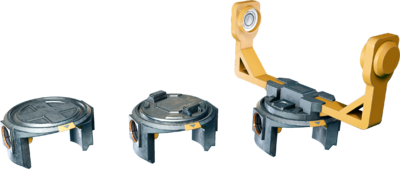Difference between revisions of "Rail mover"
m (German language link added) |
|||
| Line 3: | Line 3: | ||
|fr=Rail_mover:fr | |fr=Rail_mover:fr | ||
|zh-cn=轨道车 | |zh-cn=轨道车 | ||
|ru=Рельсовый двигатель | |||
|ua=Рейковий Двигун | |||
}} | }} | ||
== Summary == | == Summary == | ||
Revision as of 11:06, 9 September 2020
Summary

Three different rail mover entities exist: basic, turntable, and jointed for machinery.
Rails can be used to create anything that moves on rails, like elevators, gun turrets, and factory lines.
The primary use for rails however is automation.
Basic information
The mover is the device which is located on the rail and performs the actual locomotion of other devices on top of it.
Rail movers are controlled by using a YOLOL variable; by default, the "speed" variable.
A mover will automatically connect to any rail it is on, and can only move along the rails.
Anything connected to the sockets or plugs of a mover will also be on the same network as the mover.
This means that devices properly connected through a mover can be YOLOL-controlled from the same network as the mover.
Rail movers will move in the direction of the arrow on the mover.
In the case of a negative speed, rail movers will move in the opposite direction of the arrow.
Videos
Device fields
Note! Rail movers can be controlled directly by changing the field value with universal tool, but it's more common to control the speed with a lever.
| YOLOL field | description | range |
|---|---|---|
| speed | Target velocity of the rail mover in m/s | |
| RailMoverTriggerValue | If we cross a rail trigger that is configured to emit values read from the mover, it reads from this field. |
Additionally, the small mover has a hinge on it, so it inherits those device fields as well.